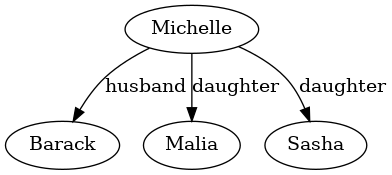Difference between revisions of "SiGNaL"
| Line 30: | Line 30: | ||
A [https://en.wikipedia.org/wiki/Variable_(computer_science) variable] holds a value. | A [https://en.wikipedia.org/wiki/Variable_(computer_science) variable] holds a value. | ||
E.g. The variable "name" might hold the value for one of the Obama family members. | E.g. The variable "name" might hold the value for one of the Obama family members. | ||
| + | ==== Example Java Source code ==== | ||
<source lang='java'> | <source lang='java'> | ||
name="Michelle"; | name="Michelle"; | ||
Revision as of 13:29, 19 February 2018
What happens if you view the world as a graph?
It depends on your view point. The first point of view you choose might be your starting point. If you look from a starting point in time you might end up with starting your analysis of the world with the big bang if you are a physicist or from the Genesis if you look from a religious point of view.
If you are more pragmatic you'll look from where you are right now.

Example: Family
Just imagine for a moment that you'd be Michelle Obama.
From your viewpoint there are a few persons you are most interested in - your family:


Knowledge representation
The following approaches are mainly used for knowlege representation:
- Variables
- Records
- Lists
- Trees
- Graphs
Variables
A variable holds a value. E.g. The variable "name" might hold the value for one of the Obama family members.
Example Java Source code
name="Michelle";
name="Barack";
name="Malia";
name="Sasha";
Records
To record interesting details about individual things the Record was invented. There is one record for each individual (thing).
Example Record Barack Obama
- date of birth: 4 August 1961
- married: 3 October 1992
- height: 1.85 m
- residence: Kalorama (as of 2017-01)
- nickname: Barry
see WikiData Q76 - Barack Obama
Example Record clay table with a record of beer
Below you can see a 5000 year old record of beer

Lists
List of Breweries
# Find World wide breweries using the Wikidata Query service
# taken from
# http://wiki.bitplan.com/index.php/SiGNaL#List_of_Breweries
# Created 2018-01 by Wolfgang Fahl BITPlan GmbH
#
# display the results as a map
#defaultView:Map
#
# select the distillery and its coordinates
SELECT ?brewery ?coord
WHERE
{
# any subject
# which is an instance of
# https://www.wikidata.org/wiki/Property:P31
# brewery
# https://www.wikidata.org/wiki/Q131734
?brewery wdt:P31 wd:Q131734.
# get the coordinate location value for any found distillery
# https://www.wikidata.org/wiki/Property:P625
?brewery wdt:P625 ?coord.
}
Trees
By Carl Linnaeus - Scanned from a facimile, Public Domain, Link
see also http://shapeofthought.typepad.com/shape_of_thought/2010/07/revisioning-trees.html
Graphs
Models
Phaidro's knife
"I should talk now about Phaedrus' knife ... The application of this knife, the division of the world into parts and the building of this structure, is something everybody does. All the time we are aware of millions of things around us - these changing shapes, these burning hills, the sound of the engine, the feel of the throttle, each rock and weed and fence post and piece of debris beside the road - aware of these things but not really conscious of them unless there is something unusual or unless they reflect something we are predisposed to see. We could not possibly be conscious of these things and remember all of them because our mind would be so full of useless details we would be unable to think. From all this awareness we must select, and what we select and call consciousness is never the same as the awareness because the process of selection mutates it. We take a handful of sand from the endless landscape of awareness around us and call that handful of sand the world.
Once we have the handful of sand, the world of which we are conscious, a process of discrimination goes to work on it. This is the knife. We divide the sand into parts. This and that. Here and there. Black and white. Now and then. The discrimination is the division of the conscious universe into parts.
The handful of sand looks uniform at first, but the longer we look at it the more diverse we find it to be. Each grain of sand is different. No two are alike. Some are similar in one way, some are similar in another way, and we can form the sand into separate piles on the basis of this similarity and dissimilarity. Shades of color in different piles - sizes in different piles - grain shapes in different piles - subtypes of grain shapes in different piles - grades of opacity in different piles - and so on, and on, and on. You'd think the process of subdivision and classification would come to an end somewhere, but it doesn't. It just goes on and on.
Classical understanding is concerned with the piles and the basis for sorting and interrelating them. Romantic understanding is directed toward the handful of sand before the sorting begins. Both are valid ways of looking at the world although irreconcilable with each other.
What has become an urgent necessity is a way of looking at the world that does violence to neither of these two kinds of understanding and unites them into one. Such an understanding will not reject sand-sorting or contemplation of unsorted sand for its own sake. Such an understanding will instead seek to direct attention to the endless landscape from which the sand is taken. That is what Phædrus, the poor surgeon, was trying to do.
To understand what he was trying to do it's necessary to see that part of the landscape, inseparable from it, which must be understood, is a figure in the middle of it, sorting sand into piles. To see the landscape without seeing this figure is not to see the landscape at all. [...]
When analytic thought, the knife, is applied to experience, something is always killed in the process. That is fairly well understood, at least in the arts. Mark Twain's experience comes to mind, in which, after he had mastered the analytic knowledge needed to pilot the Mississippi River, he discovered the river had lost its beauty. Something is always killed. But what is less noticed in the arts - something is always created too. And instead of just dwelling on what is killed it's important also to see what's created and to see the process as a kind of death-birth continuity that is neither good nor bad, but just is." Robert M. Pirsig - Zen and the art of motorcycle maintainance.
Mental Model
Links
- https://en.wikipedia.org/wiki/Perception
- https://en.wikipedia.org/wiki/Ontology_(information_science)
- https://github.com/arago/OGIT/wiki/High-level-use-cases
- The Genesis of WikiData
- Upper Ontology
- http://shapeofthought.typepad.com/shape_of_thought/2010/07/index.html
- https://en.wikipedia.org/wiki/Knowledge_Interchange_Format

